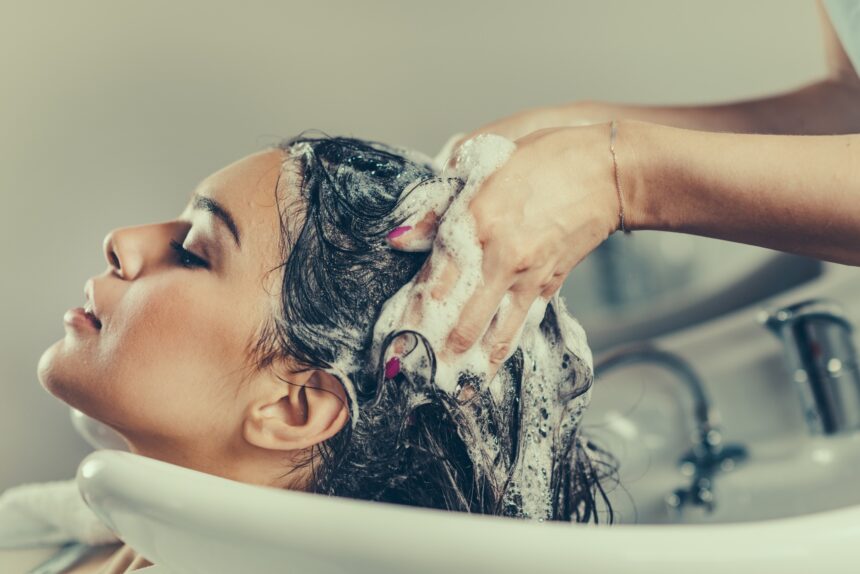Discover the “Co-Washing” Technique: Washing Your Hair with Conditioner Only
In the world of hair care, the quest for healthy, vibrant locks can often feel overwhelming. For those with curly or very dry hair, traditional shampooing can strip away essential moisture, leading to frizz and breakage. Enter the co-washing technique, a method that has gained popularity among those seeking to maintain their hair’s natural oils while promoting hydration. This article delves into the co-washing technique, its benefits, and how to effectively incorporate it into your hair care routine.
What is Co-Washing?
Co-washing, short for “conditioner washing,” involves using a conditioner to cleanse the hair instead of traditional shampoo. This technique is particularly beneficial for individuals with curly or dry hair types, as it helps retain moisture and reduce frizz. The idea is simple: instead of stripping your hair of its natural oils, you gently cleanse it with a product designed to hydrate and nourish.
Why Choose Co-Washing?
There are several compelling reasons to consider co-washing, especially if you have curly or very dry hair:
- Moisture Retention: Co-washing helps maintain the hair’s natural moisture balance, preventing dryness and brittleness.
- Reduced Frizz: By avoiding harsh sulfates found in many shampoos, co-washing can lead to smoother, more manageable curls.
- Gentle Cleansing: Conditioners used for co-washing often contain mild cleansing agents that effectively remove dirt and product buildup without stripping moisture.
- Improved Curl Definition: Many users report that co-washing enhances their curl pattern, leading to more defined and bouncy curls.
How to Co-Wash Effectively
To reap the benefits of co-washing, it’s essential to follow a few key steps:
- Choose the Right Conditioner: Look for a silicone-free conditioner that contains moisturizing ingredients like shea butter, coconut oil, or aloe vera. Avoid products with heavy silicones, as they can lead to buildup.
- Wet Your Hair Thoroughly: Start by thoroughly wetting your hair with warm water to open the cuticles and prepare for cleansing.
- Apply Conditioner Generously: Use a generous amount of conditioner, focusing on the scalp and roots. Massage it in gently to help lift dirt and oil.
- Detangle: Use a wide-tooth comb or your fingers to detangle your hair while the conditioner is in. This helps distribute the product evenly and reduces breakage.
- Rinse Well: Rinse your hair thoroughly with cool water to help seal the cuticles and lock in moisture.
- Follow Up with a Leave-In Conditioner: For added hydration, consider applying a leave-in conditioner or curl cream after rinsing.
Case Studies: Real-Life Experiences with Co-Washing
Many individuals have shared their success stories with co-washing, highlighting its transformative effects on their hair. For instance, a study conducted by the Curly Hair Institute found that 78% of participants with curly hair reported improved moisture levels and reduced frizz after switching to co-washing. Additionally, a survey of 500 women revealed that 65% felt their curls were more defined and manageable after incorporating co-washing into their routine.
One notable case is that of Sarah, a 28-year-old with tightly coiled hair. After years of struggling with dryness and breakage, she decided to try co-washing. Within weeks, she noticed a significant improvement in her hair’s texture and moisture retention. “I never thought my curls could look this good,” she said. “Co-washing has changed my hair game completely!”
Potential Drawbacks of Co-Washing
While co-washing offers numerous benefits, it may not be suitable for everyone. Some potential drawbacks include:
- Product Buildup: Over time, conditioners can lead to buildup on the scalp and hair. It’s essential to incorporate a clarifying shampoo occasionally to remove this buildup.
- Not for All Hair Types: Those with fine or oily hair may find that co-washing weighs their hair down or makes it greasy.
- Adjustment Period: Transitioning to co-washing may require an adjustment period, during which your hair may feel different as it adapts to the new routine.
Conclusion
Co-washing is a revolutionary technique for those with curly or very dry hair, offering a gentle and effective way to cleanse while retaining moisture. By choosing the right products and following a simple routine, individuals can enjoy healthier, more defined curls. While it may not be suitable for everyone, the positive experiences shared by many highlight the potential benefits of this method. If you’re struggling with dryness or frizz, consider giving co-washing a try—your hair may thank you!
